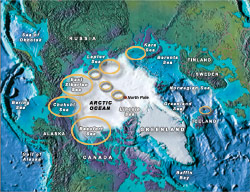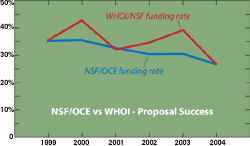 |
 Enlarge image
Enlarge image |
| Jim Luyten, left, chats with Corporation Member Ted Dengler. (Photo by Elas Ruiz) |
 Enlarge image
Enlarge image |
| Highlighted areas denote locations of selected polar projects by WHOI investigators. Rindy
Ostermann is working north of Iceland; Andrey Proshutinsky, Al Plueddemann, and John Toole
in the Beaufort Sea; Carin Ashjian and Bob Pickart in the Bering Strait and Chukchi Sea. Peter
Winsor and Breck Owens are deploying fl oats across the Arctic Ocean. Several projects are also
pending or underway in Antarctica. |
 Enlarge image
Enlarge image |
| The National Science Foundation is the largest supporter of WHOI science, with most NSF funds coming from proposals submitted to the Division of Ocean Sciences (OCE). The NSF funding rate—the number of projects funded vs. proposals
submitted—is declining as demand for NSF support has outpaced the agency’s budget increases. |
| |
| Related Links |
» WHOI Arctic Group
» Spray Glider
» CLIMODE
» VERTIGO
» Woods Hole Center for Oceans and Human Health
|
Shrinking federal investments in basic research will make
the coming years challenging for Woods Hole Oceanographic
Institution. Despite this out look, the Institution’s
research and engineering achievements continue. We are prepared
for rough waters in the short term, and are preparing for
a new way of funding basic research in the long term.
Achievements
By the end of 2004, we had approximately $120 million in hand
for funding of 865 research projects. Continuing the trend
over the last few years, our Biology Department and Applied
Ocean Physics and Engineering Department show most rapid growth
in personnel and in the number and size of sponsored research
projects. Our scientists made significant advances in earthquake
research, involving the application of mathematical models
to the extensive databases for earthquakes on the East Pacific
Rise, leading to a better understanding of early release of
stress that may ultimately provide some predictive capability.
Jeff McGuire, graduate student Margaret Boettcher, and colleagues
have led this effort. Jian Lin, with Uri ten Brink of the
U.S. Geological Survey, reported their work on assessing the
potential for tsunami-generating earthquakes in the Caribbean
in December.
The sensitivity of the polar seas to global changes in climate
has led to a large, and growing, research effort to understand
the complex relations that control marine life, as well as
the processes that control the balance between fresh and salty
water—which in turn influences earth’s climate. We have more
than 40 funded projects scheduled for the Arctic and Antarctic,
involving more than 30 investigators from a wide range of
disciplines, including biologists Carin Ashjian, Peter Wiebe,
Scott Gallager; physical oceanographers Andrey Proshutinsky,
Bob Pickart, Fiamma Straneo, Al Plueddemann, and John Toole,
geologist Rob Reves-Sohn, and engineering scientist Hanu Singh.
Some of the polar areas of interest to these scientists are
highlighted in the map (right). We expect to play a significant
role in International Polar Year, a coordinated effort starting
in 2007 to focus on leading polar science questions.
The prospect of making observations from autonomous platforms
has been a dream for oceanographers for decades. This dream
is finally becoming realized. An autonomous transect of the
Gulf Stream south of New England was accomplished this year
by Breck Owens and Scripps collaborators, using the Spray
glider. In addition, Dave Fratantoni participated with the
Naval Oceanographic Office in a field program in the Phillipine
Sea with five Slocum gliders to test the concept of using
a mobile array of gliders as synthetic moorings, using the
measurements to initialize and then validate numerical models.
Christopher von Alt and colleagues in the Oceanographic Systems
Laboratory delivered to the Navy a second autonomous underwater
vehicle rated for depths to 6,000 meters. The vehicle successfully
conducted more than 5,000 nautical miles of deep ocean surveys
for the Naval Oceanographic Office.
Also started in 2004 was the work of Dennis McGillicuddy’s
group and colleagues in many institutions on biological-physical
interactions in the Sargasso Sea to better understand the
effect on biological productivity of ocean eddies, which are
hundreds of kilometers across. The eddies, sometimes referred
to as the “internal weather of the sea,” are highly
energetic and ubiquitous features of ocean circulation. They
perturb the chemical and biological environment that can dramatically
impact biogeochemical cycling in the ocean.
Following a recommendation made in 2004 by the “Access
to the Sea” task force, an internal fund has been established
to foster the development of state-of-the-art sea-going technologies
and support high-risk or innovative sea-going research. The
first projects are due for selection in 2005.
Near-term prospects
Much of our existing funding is for ongoing projects, which
have been funded in the past few years for three to five years.
In addition, there are significant new projects. Some of these
include the Clivar Mode Water Dynamics experiment (CLIMODE),
a large, multi-institutional observational program to understand
the formation and maintenance of large bodies of water adjacent
to strong currents (such as the Sargasso Sea, along the south
side of the Gulf Stream) and their role in climate. Andrey
Proshutinsky is leading a group of investigators working in
the Beaufort Gyre, off the Alaska north coast, to understand
its role in the balance of fresh and salty water, and its
influence on global heat distribution.
As part of an international effort called VERTIGO (VERtical
Transport In the Global Ocean), WHOI scientists and technicians
Ken Buesseler, Jim Valdes, Tom Trull, Karen Casciotti, Ben
Van Mooy, and Steve Manganini are studying processes that
control the sinking of particles from the ocean surface to
depths of 1,000 meters. This work will enhance modeling of
the global carbon budget and understanding of the role of
carbon in the global climate.
Biology is thriving because its funding base is highly diverse,
and because it has become an international scientific focus
driven by extraordinary developments in genomics, proteomics,
and in the oceans in particular because of the observational
capabilities developed in the past 10 years. The Woods Hole
Center for Oceans and Human Health, one of four in the country,
exemplifies the application of modern understanding in biology
to addressing issues of immediate human interest.
The longer view
Despite the decrease in National Science Foundation (NSF)
funds overall for 2005, the Foundation will still spend more
than $300 million in basic research in ocean science per year.
Our scientists and engineers are very competitive (figure
at right) and we anticipate that we will continue to participate
substantially in the major oceanographic initiatives in the
coming decade. We also expect to continue to receive substantial
funding for individual investigators and major facilities,
such as the accelerator mass spectrometer, ships, and submersibles.
We continue to attract highly qualified candidates for new
scientific and technical positions.
In addition, advances in instrumentation and technology make
possible measurements and understanding that was previously
beyond our reach. This advancement is moving faster than the
required increase in funding. To fully harness these emerging
capabilities, we will require a more diverse funding base.
Roughly eighty percent of the federal funding we need will
still come from traditional sources, such as NSF, the Office
of Naval Research, the National Oceanic and Atmospheric Administration,
and the National Institutes of Health. The remainder will
need to come from new sources.
Escalating competition for federal research funds is contributing
to growing risk aversion in basic science funding. As a result,
private funding—which underwrites 20% of WHOI science
today—will become increasingly important to demonstrate
success and smooth the way for subsequent federal support.
This is already happening within our Ocean Institutes and
other internal programs.
In the larger picture, not only is funding for basic research
continuing to decline at most federal agencies, the character
of the funding is changing. There is more focus on applied
problems. Unlike the funding for basic research, this money
comes with more strings attached, more rigid timelines, and
firmer expectations of results. To participate in this world,
our scientists’ way of working will need to change to accommodate
the different requirements of the funding agencies. Some of
our scientists and engineers have been successful at navigating
in this world. We are exploring ways, within the Institution’s
culture, to create an environment that enables more scientists
and engineers to take advantage of these opportunities.

James R. Luyten
Executive Vice President
and Director of Research
|

